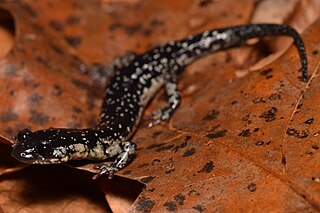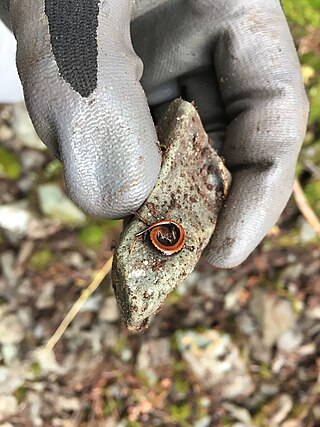
Plethodon is a genus of salamanders in the family Plethodontidae. They are commonly known as woodland salamanders. All members of the genus are endemic to North America. They have no aquatic larval stage. In some species, such as the red-backed salamander. Young hatch in the adult form. Members of Plethodon primarily eat small invertebrates. The earliest known fossils of this genus are from the Hemphillian of Tennessee in the United States.

The Siskiyou Mountains salamander, also called the Siskiyou Mountain salamander, exists only in isolated locations along the Klamath River in northern California and southern Oregon. It is a close relative of the Del Norte salamander, and some herpetologists believe it may be a subspecies of that animal.

The northern slimy salamander is a species of terrestrial plethodontid salamander found throughout much of the eastern two-thirds of the United States.

The Blue Ridge gray-cheeked salamander is a species of salamander in the family Plethodontidae endemic to the Blue Ridge Mountains of North Carolina, United States. It is one of 55 species in the genus Plethodon and one of the most recently to be described. Its natural habitat is temperate forests. It is threatened by habitat loss.

The Ozark zigzag salamander is a species of salamander in the family Plethodontidae endemic to the United States. It is one of 57 species in the genus Plethodon. Its natural habitats are temperate forests, freshwater springs, rocky areas, and caves. It is threatened by habitat loss.

The Caddo Mountain salamander is a species of salamander in the family Plethodontidae endemic to Arkansas in the south-central United States, and only known from the Caddo Mountains, a part of the Ouachita Mountains.

The Cheoah Bald salamander is a species of salamander in the family Plethodontidae endemic to the state of North Carolina in the United States. Its natural habitat is temperate forests and it is threatened by habitat loss. It was formerly considered a variant of the red-cheeked salamander until it was found to be a distinct species.

The white-spotted slimy salamander is a species of salamander in the family Plethodontidae endemic to the Eastern United States. It is one of 55 species in the genus Plethodon, and was one of the first to be described of its cogeners. The preferred habitat of this species is under logs and leaf litter in shaded hardwood forests and wooded floodplains, and often forages on the forest floor on wet nights. It was found that with increasing temperatures, the aggression in this species also increases. In the plethodon genus, species have a lungless morphology, restricting nearly all gas and water exchange transport to the body surface. This species mainly consumes insects, including ants, centipedes, springtails, crickets, millipedes, slugs, snout-beetles, and earthworms. Common predators of this species are gartersnakes, copperheads, and birds. One of their predator defense mechanisms is the release of noxious/sticky substances through the skin by the dorsal granular glands. Another predator deterrent is when touched, this species will freeze in place and become immobile. This species of Plethodon are mostly terrestrial and deposit their direct-developing eggs on land that omits the aquatic larval stage characteristic of most amphibians, therefore this species is not restricted to aquatic habitats for reproduction and dispersal. This species, along with other Plethodontid salamanders, are frequently parasitized by Trombicula mites.

The northern ravine salamander is a species of salamander in the family Plethodontidae. The species is endemic to the United States.

The Fourche Mountain salamander is a species of salamander in the family Plethodontidae endemic to the Ouachita Mountains in the central United States. Its natural habitat is temperate forests and it is threatened by habitat loss.

The Cumberland Plateau salamander is a species of salamander in the family Plethodontidae. It is endemic to the Cumberland Plateau, the southeastern United States. Its natural habitat is temperate forests. It is threatened by habitat loss.

The Kiamichi slimy salamander is a species of salamander in the family Plethodontidae endemic to the United States, has a natural habitat of temperate forests, and is found over a small range. This nocturnal species is mainly threatened by habitat loss and was first described by Highton in 1989. It is rated as a vulnerable species by the International Union for Conservation of Nature.

The Larch Mountain salamander is a species of salamander in the family Plethodontidae endemic to the United States. It occurs in the Cascade Mountains of southern Washington and northern Oregon. In Washington, it occurs from the Columbia River Gorge to just north of Snoqualmie Pass. Its natural habitats are temperate forests and rocky areas. It is threatened by habitat loss.

The northern gray-cheeked salamander is a species of salamander in the family Plethodontidae and endemic to the Blue Ridge Mountains and Appalachian Mountains in the eastern United States. It is closely related to the Red-cheeked salamander and the Red-legged salamander. Its natural habitat is temperate forests. It is found under moss, rocks, logs, and bark in cool, moist forests above 2500 feet. Especially found in spruce-fir forests. The Gray-cheeked Salamander commonly eats millipedes, earthworms, crane flies, spiders, and centipedes and less commonly eats ants, mites, and springtails. They eat spiders, moths, flies, beetles, bees, and snails. The male and female perform a courtship, where the male nudges the female with his snout, does a foot dance, then circles under the female and the two then walk together. Like other salamanders, they do not migrate or aggregate during breeding season. It is threatened by habitat loss.
The Jemez Mountains salamander is a species of salamander in the family Plethodontidae endemic to New Mexico in the United States. Its natural habitat is temperate forests. It is threatened by habitat loss, is in rapid decline, and was placed on the IUCN Red List in 2013.

The Sequoyah slimy salamander is a species of salamander in the family Plethodontidae.

The southern zigzag salamander is a species of salamander in the family Plethodontidae. It is endemic to the United States.

The Webster's salamander is a species of salamander in the family Plethodontidae. It is endemic to the southeast United States, in patchy and disjunct lowland subpopulations ranging from South Carolina to Louisiana. Its natural habitat is mixed mesophytic temperate forests, in association with rocky streams and outcrops.


















